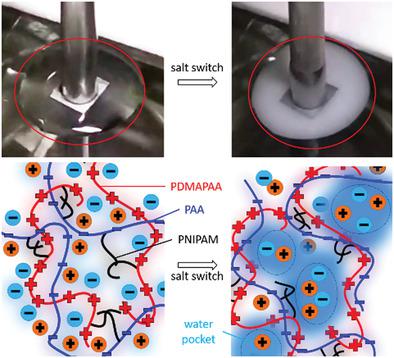当前位置:
X-MOL 学术
›
Adv. Mater. Interfaces
›
论文详情
Our official English website, www.x-mol.net, welcomes your
feedback! (Note: you will need to create a separate account there.)
Underwater Adhesion of Multiresponsive Complex Coacervates
Advanced Materials Interfaces ( IF 4.3 ) Pub Date : 2019-12-26 , DOI: 10.1002/admi.201901785 Marco Dompé 1 , Francisco J. Cedano‐Serrano 2 , Mehdi Vahdati 2 , Larissa Westerveld 3 , Dominique Hourdet 2 , Costantino Creton 2 , Jasper Gucht 1 , Thomas Kodger 1 , Marleen Kamperman 1, 3
Advanced Materials Interfaces ( IF 4.3 ) Pub Date : 2019-12-26 , DOI: 10.1002/admi.201901785 Marco Dompé 1 , Francisco J. Cedano‐Serrano 2 , Mehdi Vahdati 2 , Larissa Westerveld 3 , Dominique Hourdet 2 , Costantino Creton 2 , Jasper Gucht 1 , Thomas Kodger 1 , Marleen Kamperman 1, 3
Affiliation

|
Many marine organisms have developed adhesives that are able to bond under water, overcoming the challenges associated with wet adhesion. A key element in the processing of several natural underwater glues is complex coacervation, a liquid–liquid phase separation driven by complexation of oppositely charged macromolecules. Inspired by these examples, the development of a fully synthetic complex coacervate‐based adhesive is reported with an in situ setting mechanism, which can be triggered by a change in temperature and/or a change in ionic strength. The adhesive consists of a matrix of oppositely charged polyelectrolytes that are modified with thermoresponsive poly(N‐isopropylacrylamide) (PNIPAM) grafts. The adhesive, which initially starts out as a fluid complex coacervate with limited adhesion at room temperature and high ionic strength, transitions into a viscoelastic solid upon an increase in temperature and/or a decrease in the salt concentration of the environment. Consequently, the thermoresponsive chains self‐associate into hydrophobic domains and/or the polyelectrolyte matrix contracts, without inducing any macroscopic shrinking. The presence of PNIPAM favors energy dissipation by softening the material and by allowing crack blunting. The high work of adhesion, the gelation kinetics, and the easy tunability of the system make it a potential candidate for soft tissue adhesion in physiological environments.
中文翻译:

多响应复合凝聚层的水下附着力
许多海洋生物已经开发出能够在水下粘合的粘合剂,克服了湿粘合带来的挑战。几种天然水下胶粘剂加工中的关键要素是复杂凝聚,这是由带相反电荷的大分子的复合驱动的液-液相分离。受这些例子的启发,据报道,一种完全合成的基于凝聚层的胶粘剂具有原位固化机理,可以通过温度变化和/或离子强度变化来触发。粘合剂由带相反电荷的聚电解质基质组成,该基质被热响应性聚(N-异丙基丙烯酰胺)(PNIPAM)接枝。胶粘剂最初是在室温下以有限的粘合力开始形成的流体复合物凝聚层,在温度升高和/或环境盐浓度降低时转变为粘弹性固体。因此,热响应链自动缔合到疏水域和/或聚电解质基体收缩,而不会引起任何宏观收缩。PNIPAM的存在通过软化材料并允许裂纹钝化而有利于能量消散。该系统的高附着力,胶凝动力学和易调节性使其成为生理环境中软组织附着力的潜在候选者。
更新日期:2019-12-26
中文翻译:

多响应复合凝聚层的水下附着力
许多海洋生物已经开发出能够在水下粘合的粘合剂,克服了湿粘合带来的挑战。几种天然水下胶粘剂加工中的关键要素是复杂凝聚,这是由带相反电荷的大分子的复合驱动的液-液相分离。受这些例子的启发,据报道,一种完全合成的基于凝聚层的胶粘剂具有原位固化机理,可以通过温度变化和/或离子强度变化来触发。粘合剂由带相反电荷的聚电解质基质组成,该基质被热响应性聚(N-异丙基丙烯酰胺)(PNIPAM)接枝。胶粘剂最初是在室温下以有限的粘合力开始形成的流体复合物凝聚层,在温度升高和/或环境盐浓度降低时转变为粘弹性固体。因此,热响应链自动缔合到疏水域和/或聚电解质基体收缩,而不会引起任何宏观收缩。PNIPAM的存在通过软化材料并允许裂纹钝化而有利于能量消散。该系统的高附着力,胶凝动力学和易调节性使其成为生理环境中软组织附着力的潜在候选者。









































 京公网安备 11010802027423号
京公网安备 11010802027423号